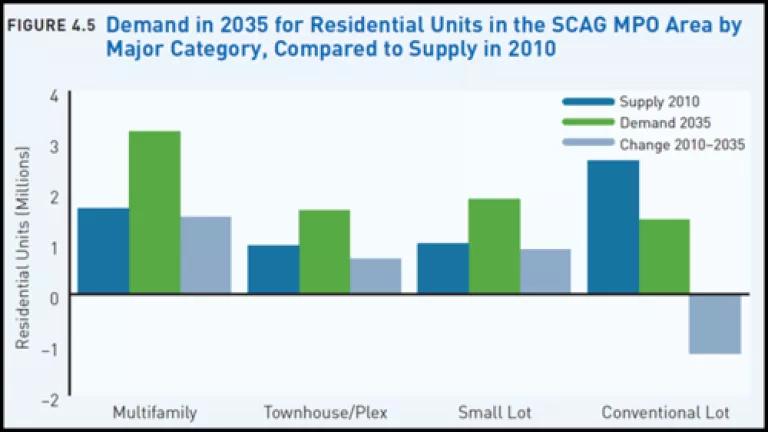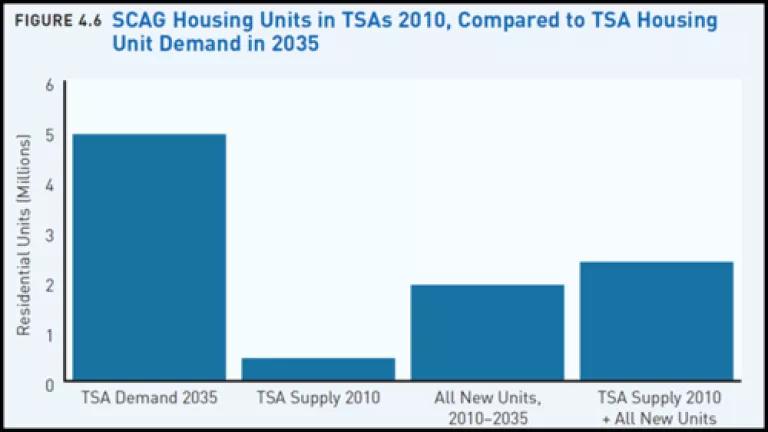Five recommendations for a transformative Sustainable Communities Strategy in Southern California

Whenever I tell my New York City family that I’m working to create transit in LA, I get a quizzical look that falls somewhere between skepticism and outright disbelief: “You can’t take transit in LA!” “You can’t even walk there!”
It’s hard to blame them. For many, the mere mention of Los Angeles conjures images of 12-lane freeways, maddening gridlock, and unrelenting poor air quality. But the Sustainable Communities Strategy (SCS) that the Southern California Association of Governments (SCAG) regional board will adopt under SB 375 in just under a month aims to take the region in a very different direction. One where transit, biking and walking all play more significant roles in helping the region reach its environmental goals—not to mention providing badly-needed mobility options.
NRDC staff have played an active role in shaping the development of this plan over the past year. Our full comment letter on the Regional Transportation Plan can be found here. Below we highlight the areas where this plan excels as well as our final recommendations for its improvement before the full board adoption on April 4th, 2012.
What we like:
- Market-responsive housing mix: Responding to the growing market demand for walkable communities, the plan will house 68% of new development in multi-family housing, as opposed to 39% in the last 25 years, with most of the balance going into small-lot single family homes and townhomes.[i] The chart below from the Urban Land Institute’s The New California Dream confirms the strong demand for multi-family and small lot single family housing in SoCal, as well as finding that SCAG has more large-lot single family “sprawl” homes now than will be needed even 20 years in the future. People are choosing to live in walkable areas near transit.
- Housing near transit: By locating new housing near transit, and expanding transit into existing communities, by 2035, 82% of all development will be within ½ mile of transit. This is the right direction, as the ULI study finds that even if all new development now to 2035 was built near transit, the region will still fall short of its overwhelming 2035 demand for housing in these locations;

- Improves air quality: Achieves a 24 percent reduction in pollution-caused respiratory problems, resulting in a reduction of $1.5 billion in health care costs per year;
- Reduces congestion: Reduces congestion in spite of adding four million new residents to the region;
- Saves open space: Through an emphasis on walkable communities, the plan reduces open space development by 400 square miles, and;
- Reduces harmful emissions: The plan achieves its 2020 state assigned greenhouse gas reduction target and manages to exceed its 2035 target.
Clearly there are reasons to congratulate the SCAG staff for the work they’re doing. And yet, there is room for improvement, particularly in the area of prioritizing transportation investments to match the land use pattern.
How SCAG can and should improve the plan:
- Build out the Metrolink system the region needs and deserves. In particular, move the Metrolink grade separations, track upgrades, electrification, and service enhancements identified in the Strategic (wish list) plan for the RTP into the constrained (real) plan, with a goal of doubling ridership by 2020 and doubling it again by 2035.
- Respond to the overwhelming public support voiced for active transportation (bicycling and walking) by doubling funds in the plan. Currently the plan allocates just 1.3% of total funds ($6 billion) to these sustainable modes which are critical to making transit accessible, and which currently accommodate 20 % of all trips. We recommend at least a doubling to $12 billion, which would still represent less than 3% of total revenues.
- Commit to funding Compass Blueprint grants to ensure local governments have adequate resources to implement the Sustainable Communities Strategy. The Compass Blueprint Program provides planning grants for cities to undertake revisions to their general plans, specific plans, and zoning codes to create more walkable, vibrant, healthy communities. In order to deliver on the promise of this plan, SCAG needs to make a solid commitment to funding this program—in the plan—at a level no less than $5 million annually. (The true need is probably closer to $30M/year, per SCAG staff).
- Create a freight movement distribution network that is worthy of a Sustainable Communities Strategy. Addressing pollution from freight movement is critical to protecting public health in the region. Both SCAG and the regional and state air quality agencies have determined that the region must move to a zero or near-zero emissions means of moving freight to meet federal and state air quality standards. While the plan includes some discussion of long term projects, the constrained plan must include near-term projects—such as providing electrical infrastructure on the Terminal Island Freeway, which connects the ports to the Intermodal Container Transfer Facility—to ensure adequate progress in moving to a cleaner way to move freight.
- Commit to a project performance analysis process post SCS adoption. SCAG’s fellow Metropolitan Planning Organization to the north—the Bay Area—has engaged in a groundbreaking process through their SCS development to analyze whether major transportation projects are helping—or in fact hurting—the region’s ability to meet its social and environmental goals. The project has yielded some fascinating findings about how to prioritize the region’s transportation dollars, and in the intervening years between 2012 and SCAG’s next RTP in 2016 we would like to see SCAG, in partnership with its six member County Transportation Commissions, undertake a similar analysis. This commitment should be made in SCAG’s adopting resolution on April 4th, 2012.
SCAG staff has taken significant strides with this SCS to set the region on a more direct path to sustainability. In particular, the land use pattern shows a substantial deviation from years past in its attempt to provide opportunities for Southern California residents to live in walkable communities with affordable, convenient transportation options. However, more work is necessary to adjust the priorities in the transportation system to ensure it provides the choices and mobility that SCAG envisions and that SoCal residents deserve.
[i]http://www.uli.org/sitecore/content/ULI2Home/News/PressReleases/Archives/2011/2011PressReleases/~/media/ResearchAndPublications/Report/ULI%20Voices%20Nelson%20The%20New%20California%20Dream.ashx
